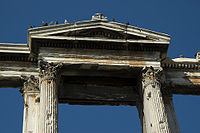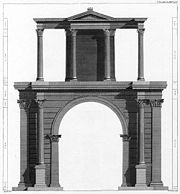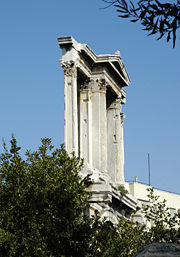
Arch of Hadrian
Encyclopedia

Gate
A gate is a point of entry to a space enclosed by walls, or a moderately sized opening in a fence. Gates may prevent or control entry or exit, or they may be merely decorative. Other terms for gate include yett and port...
way resembling – in some respects - a Roman triumphal arch
Triumphal arch
A triumphal arch is a monumental structure in the shape of an archway with one or more arched passageways, often designed to span a road. In its simplest form a triumphal arch consists of two massive piers connected by an arch, crowned with a flat entablature or attic on which a statue might be...
. It spanned an ancient road from the center of Athens
Classical Athens
The city of Athens during the classical period of Ancient Greece was a notable polis of Attica, Greece, leading the Delian League in the Peloponnesian War against Sparta and the Peloponnesian League. Athenian democracy was established in 508 BC under Cleisthenes following the tyranny of Hippias...
, Greece
Ancient Greece
Ancient Greece is a civilization belonging to a period of Greek history that lasted from the Archaic period of the 8th to 6th centuries BC to the end of antiquity. Immediately following this period was the beginning of the Early Middle Ages and the Byzantine era. Included in Ancient Greece is the...
, to the complex of structures on the eastern side of the city that included the Temple of Olympian Zeus. It has been proposed that the arch was built to celebrate the adventus
Adventus (ceremony)
The adventus was a ceremony in ancient Rome, in which an emperor was formally welcomed into a city either during a progress or after a military campaign, often Rome. The term is also used to refer to artistic depicitions of such ceremonies. Its 'opposite' is the profectio.-External links:*...
(arrival) of the Roman Emperor
Roman Emperor
The Roman emperor was the ruler of the Roman State during the imperial period . The Romans had no single term for the office although at any given time, a given title was associated with the emperor...
Hadrian
Hadrian
Hadrian , was Roman Emperor from 117 to 138. He is best known for building Hadrian's Wall, which marked the northern limit of Roman Britain. In Rome, he re-built the Pantheon and constructed the Temple of Venus and Roma. In addition to being emperor, Hadrian was a humanist and was philhellene in...
and to honor him for his many benefactions to the city, on the occasion of the dedication of the nearby temple complex in 131 or 132 AD. It is not certain who commissioned the arch, although it is probable that the citizens of Athens or another Greek group were responsible for its construction and design. There were two inscriptions on the arch, facing in opposite directions, naming both Theseus and Hadrian as founders of Athens. While it is clear that the inscriptions honor Hadrian, it is uncertain whether they refer to the city as a whole or to the city in two parts: one old and one new. The early idea, however, that the arch marked the line of the ancient city wall, and thus the division between the old and the new regions of the city, has been shown to be false by further excavation. The arch is located 325m southeast of the Acropolis
Acropolis of Athens
The Acropolis of Athens or Citadel of Athens is the best known acropolis in the world. Although there are many other acropoleis in Greece, the significance of the Acropolis of Athens is such that it is commonly known as The Acropolis without qualification...
.
Material and design

Penteli
Pentéli or Pendeli, , and Vrilissos or Vrilittos , Mendeli in medieval times) is a tall mountain and mountain range situated northeast of Athens and southwest of Marathon. Its elevation is 1,109 m...
, 18.2km northeast of the arch. Pentelic marble was used for the Parthenon
Parthenon
The Parthenon is a temple on the Athenian Acropolis, Greece, dedicated to the Greek goddess Athena, whom the people of Athens considered their virgin patron. Its construction began in 447 BC when the Athenian Empire was at the height of its power. It was completed in 438 BC, although...
and many other notable structures in Athens, although its quality can vary significantly. The marble used for the arch is of a lower grade that had more inclusions than that used in the best Athenian buildings. The arch was constructed without cement or mortar from solid marble, using clamps to connect the cut stones. It is 18m high, 13.5m wide, and 2.3m in depth. Its design is fully symmetrical from front to back and side to side.
The single arched passageway of the lower level is 6.5m wide and was supported by pilaster
Pilaster
A pilaster is a slightly-projecting column built into or applied to the face of a wall. Most commonly flattened or rectangular in form, pilasters can also take a half-round form or the shape of any type of column, including tortile....
s crowned with Corinthian
Corinthian order
The Corinthian order is one of the three principal classical orders of ancient Greek and Roman architecture. The other two are the Doric and Ionic. When classical architecture was revived during the Renaissance, two more orders were added to the canon, the Tuscan order and the Composite order...
capitals. Similar, but taller, pilasters flank the outer corners of the lower level. The space between the outer pilasters and the arched opening was filled in with squared stones with drafted edges to emphasize the design. On either side of the central passageway was a Corinthian column on a rectangular, raised base projecting from the center of the wall. The lower level was crowned with an Ionic architrave capped with dentil
Dentil
In classical architecture a dentil is a small block used as a repeating ornament in the bedmould of a cornice.The Roman architect Vitruvius In classical architecture a dentil (from Lat. dens, a tooth) is a small block used as a repeating ornament in the bedmould of a cornice.The Roman architect...
s and a projecting geison
Geison
Geison is an architectural term of relevance particularly to ancient Greek and Roman buildings, as well as archaeological publications of the same...
.

Architrave
An architrave is the lintel or beam that rests on the capitals of the columns. It is an architectural element in Classical architecture.-Classical architecture:...
capped with dentils and a projecting geison, in the manner of the lower level. The central opening, however, was flanked by anta
Anta
An anta is an architectural term describing the posts or pillars on either side of a doorway or entrance of a Greek temple - the slightly projecting piers which terminate the walls of the naos.In contrast to pillars, they are directly connected with the walls of a temple...
e with engaged Corinthian half-columns that supported a projecting triangular pediment, which rested above the dentils, geison, and sima that joined to those of the two wings. At the peak of the pediment, there was a small vegetal acroterion
Acroterion
An acroterion or acroterium is an architectural ornament placed on a flat base called the acroter or plinth, and mounted at the apex of the pediment of a building in the Classical style. It may also be placed at the outer angles of the pediment; such acroteria are referred to as acroteria angularia...
. The central opening of the upper level was originally closed off by a thin screen of stone, c. 7cm thick. Only the slots for its mounting are now preserved. The design of this central aediculum-like, niche of the upper level is similar to the architecture of the scaenae frons (façade of ancient stage buildings) and highly evocative of the representations of aedicula in wall painting of the 2nd Pompeian style.

Quadriga
A quadriga is a car or chariot drawn by four horses abreast . It was raced in the Ancient Olympic Games and other contests. It is represented in profile as the chariot of gods and heroes on Greek vases and in bas-relief. The quadriga was adopted in ancient Roman chariot racing...
(four-horse chariot) or similar at top center. As Willers notes, the design of the Arch of Hadrian has a very refined upper level that does not allow the mounting of major decoration on top of the attic.
Sculptural decoration
It has been proposed that there were statues positioned on top of the lower level, on either side of the central, aediculum-like, niche of the upper level, as was common for this architectural form; Theseus and Hadrian are the most commonly advanced candidates for these two statues, based on the inscriptions. Ward-Perkins has proposed that the attic held additional multiple statues, located over the projecting Corinthian columns of the lower level. In stark opposition to these proposals, Willers states that there is no evidence of the type of doweling needed to mount statuary on the top of the lower level and that the stone is far too roughly worked on the upper surface for statues to rest on it. Although Willers has done an excellent study of the lower level of the arch, permission was not granted for close study of the upper level, so his statements concerning the upper level are based on previously published measurements and images. A complete investigation of the monument, perhaps with limited excavation of the foundations as Willers suggests, remains to be done.
Inscriptions and location
Two inscriptions are carved on the architraveArchitrave
An architrave is the lintel or beam that rests on the capitals of the columns. It is an architectural element in Classical architecture.-Classical architecture:...
of the arch’s lower level, one centered over the arched opening on either side. On the northwest side (towards the Acropolis
Acropolis
Acropolis means "high city" in Greek, literally city on the extremity and is usually translated into English as Citadel . For purposes of defense, early people naturally chose elevated ground to build a new settlement, frequently a hill with precipitous sides...
), the inscription was:
- ΑΙΔ' ΕIΣΙΝ ΑΘΗΝΑΙ ΘΗΣΕΩΣ Η ΠΡΙΝ ΠΟΛΙΣ (this is Athens, the ancient city of TheseusTheseusFor other uses, see Theseus Theseus was the mythical founder-king of Athens, son of Aethra, and fathered by Aegeus and Poseidon, both of whom Aethra had slept with in one night. Theseus was a founder-hero, like Perseus, Cadmus, or Heracles, all of whom battled and overcame foes that were...
).
The inscription on the southeast side (facing the Olympeion) read:
- ΑΙΔ' ΕIΣΙΝ ΑΔΡΙΑΝΟΥ ΚΟΥΧI ΘΗΣΕΩΣ ΠΟΛΙΣ (this is the city of Hadrian, and not of Theseus).
An ancient scholium
Scholium
Scholia , are grammatical, critical, or explanatory comments, either original or extracted from pre-existing commentaries, which are inserted on the margin of the manuscript of an ancient author, as glosses. One who writes scholia is a scholiast...
(marginal note) on a manuscript of Aristides states that the emperor Hadrian, when he was expanding the city wall (of Athens), wrote (inscribed) at the boundary of the old and the new areas of Athens a double inscription matching the sense, but not the exact wording, of the inscriptions on the arch. Based on a combined reading of the arch inscriptions and the scholium, it was at first accepted that the arch stood on the line of the Themistocleian wall
Themistocles
Themistocles ; c. 524–459 BC, was an Athenian politician and a general. He was one of a new breed of politicians who rose to prominence in the early years of the Athenian democracy, along with his great rival Aristides...
and that it marked the division between the old city of Theseus and the new city of Hadrian.

Hadrianopolis
Hadrianopolis was the name of numerous cities in the ancient world, named after the Roman Emperor Hadrian, including:* Hadrianopolis in Bithynia* Hadrianopolis in Chaonia, later Justinianopolis...
in subsequent scholarly discussion. This newer, Roman section of the city was though to have been added to the ancient Greek city during the period of the pax romana (Roman peace).
Adams has proposed that the inscriptions, rather than dividing Athens into an old city of Theseus and a new city of Hadrian (Hadrianopolis), claim the entire city as a refoundation by the emperor. In this view, the inscriptions should be read: this is Athens, once the city of Theseus; this is the city of Hadrian, and not of Theseus. One option claims a part and the other the whole of Athens for the emperor. Adams has also challenged the idea that the arch was on the line of the Themistocleian wall, and this position has now been generally accepted. A gate of the Themistocleian wall has been excavated c. 140m east of the arch, which has settled the question. Stuart and Revett, who did the earliest and only complete architectural study of the arch in 1751-53 CE, were perplexed by the fact that the arch is not aligned with the Temple of Olympian Zeus, despite the fact that it is only c. 20m from the peribolos wall (boundary wall) of that complex. Excavations in the intervening time have shown that the arch is aligned with an ancient road that was roughly on the same course as modern Lysikrates street. The arch faces the Choragic Monument of Lysicrates
Choragic Monument of Lysicrates
The Choragic Monument of Lysicrates near the Acropolis of Athens was erected by the choregos Lysicrates, a wealthy patron of musical performances in the Theater of Dionysus to commemorate the award of first prize in 335/334 BCE, to one of the performances he had sponsored...
207m to the northwest along this street.
Preservation
At the time that it was recorded architecturally by Stuart and Revett in the mid 18th century, the base of the arch was buried in earth only to the level of around three feet. Given that it was thus never protected by being buried during its nearly nineteen centuries of existence, the arch entered the modern era in extraordinary condition. Although the columns of the lower level are missing, the arch is preserved to its full height and towers over modern Amalias AvenueAmalias Avenue
Vasilissis Amalias Avenue is a major avenue linking Andrea Syngrou Avenue along with Athanasiou Diakou Street, a small artery to Vouliagmenis Avenue and Panepistimiou Street along with Vassilissis Sofias Avenue...
. In recent decades, atmospheric pollution has damaged the monument. There is extensive discoloration of the stone and degradation of the inscriptions.
Patronage
Patronage of the arch has been attributed to either the Athenian state or to the Panhellenes, a newly formed association of all the Greek cities, based in Athens. Early scholarship held that the Athenians were responsible for its creation, on the argument that the quality of material and execution did not equal the other known buildings of Hadrian in Athens, and on the assumption that an emperor who loved Athens so much could not have been so arrogant as to put such an inscription on a structure of his own making. Two arches of the same scale and design were constructed at the sanctuary of DemeterDemeter
In Greek mythology, Demeter is the goddess of the harvest, who presided over grains, the fertility of the earth, and the seasons . Her common surnames are Sito as the giver of food or corn/grain and Thesmophoros as a mark of the civilized existence of agricultural society...
and Kore at Eleusis
Eleusinian Mysteries
The Eleusinian Mysteries were initiation ceremonies held every year for the cult of Demeter and Persephone based at Eleusis in ancient Greece. Of all the mysteries celebrated in ancient times, these were held to be the ones of greatest importance...
later in the 2nd century CE and dedicated to an emperor (perhaps Marcus Aurelius) by the Panhellenes. These arches flanked the propylon into the sanctuary and stood at the ends of roads to Megara
Megara
Megara is an ancient city in Attica, Greece. It lies in the northern section of the Isthmus of Corinth opposite the island of Salamis, which belonged to Megara in archaic times, before being taken by Athens. Megara was one of the four districts of Attica, embodied in the four mythic sons of King...
and to a harbor respectively. The southeastern arch had an inscription that read:
- ΤΟΙΝ ΘΕΟΙΝ ΚΑΙ ΤΩΙ ΑΥΤΟΚ[Ρ]ΑΤΟΡΙ ΟΙ ΠΑΝΕ[ΛΛΗ]ΝΕΣ (to the two goddesses and to the emperor, the Panhellenes).
The use of the same design to honor two emperors within the space of a few decades and a few kilometers has prompted the idea that the Panhellenes were responsible for the arches in both locations.
External links
- Hadrian's Arch Photographs Night photographs of Hadrian's Arch

